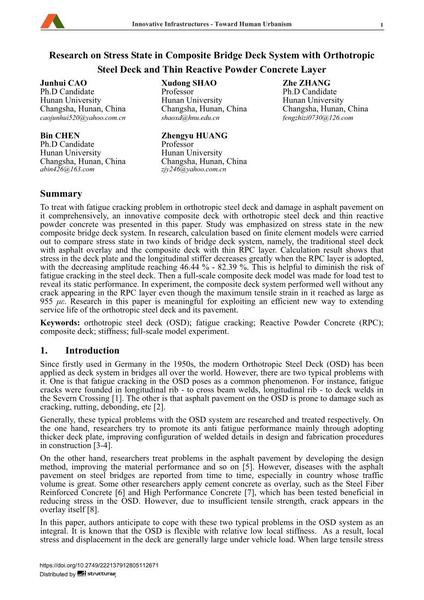Research on Stress State in Composite Bridge Deck System with Orthotropic Steel Deck and Thin Reactive Powder Concrete Layer

|
|
|||||||||||
Détails bibliographiques
| Auteur(s): |
Junhui Cao
Xudong Shao Zhe Zhang Bin Chen Zhengyu Huang |
||||
|---|---|---|---|---|---|
| Médium: | papier de conférence | ||||
| Langue(s): | anglais | ||||
| Conférence: | 18th IABSE Congress: Innovative Infrastructures – Towards Human Urbanism, Seoul, Korea, 19-21 September 2012 | ||||
| Publié dans: | IABSE Congress Seoul 2012 | ||||
|
|||||
| Page(s): | 1980-1987 | ||||
| Nombre total de pages (du PDF): | 8 | ||||
| DOI: | 10.2749/222137912805112671 | ||||
| Abstrait: |
To treat with fatigue cracking problem in orthotropic steel deck and damage in asphalt pavement on it comprehensively, an innovative composite deck with orthotropic steel deck and thin reactive powder concrete was presented in this paper. Study was emphasized on stress state in the new composite bridge deck system. In research, calculation based on finite element models were carried out to compare stress state in two kinds of bridge deck system, namely, the traditional steel deck with asphalt overlay and the composite deck with thin RPC layer. Calculation result shows that stress in the deck plate and the longitudinal stiffer decreases greatly when the RPC layer is adopted, with the decreasing amplitude reaching 46.44 % - 82.39 %. This is helpful to diminish the risk of fatigue cracking in the steel deck. Then a full-scale composite deck model was made for load test to reveal its static performance. In experiment, the composite deck system performed well without any crack appearing in the RPC layer even though the maximum tensile strain in it reached as large as 955 με. Research in this paper is meaningful for exploiting an efficient new way to extending service life of the orthotropic steel deck and its pavement. |
||||
